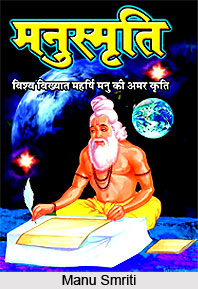 Manu Smriti, also known as the Manava Dharmasastra, is one of the nineteen Dharma sastras which belongs to the Smriti literature. Considered to be the oldest and one of the most important texts of this genre; `Manusmriti` is a `Dharmasastra` of Hindu Dharma, containing the foundational work of Hindu law and ancient Indian society. It is one of the oldest and important of the `Smritis`. `Manusmriti` contains the laws (conduct in life), which is needed to follow in various orders of life and by persons of various `varnas`. `Smritis` mean, "Those which has to be remembered".
Manu Smriti, also known as the Manava Dharmasastra, is one of the nineteen Dharma sastras which belongs to the Smriti literature. Considered to be the oldest and one of the most important texts of this genre; `Manusmriti` is a `Dharmasastra` of Hindu Dharma, containing the foundational work of Hindu law and ancient Indian society. It is one of the oldest and important of the `Smritis`. `Manusmriti` contains the laws (conduct in life), which is needed to follow in various orders of life and by persons of various `varnas`. `Smritis` mean, "Those which has to be remembered".
Also known as Manav Dharam Shastra, Manu Samhita thrives to be the earliest metrical work on Brahminical Dharma in Hinduism. Hindu mythology states, the Manusmriti is the word of Brahma, shadowing authoritative incantations of dharma. Using the eponym `Manu`, it has been presumed that he created this book, which has led the text to be coupled by Hindus with the first human being and the first king in the Indian tradition.
Manusmriti is one of the 18 `Smritis`. Manusmriti was written at time period when Brahman tradition was in serious threat by the non-Vedic movements. `Manusmriti` was highly criticised and was attacked many times by the colonial scholars, modern liberals, Hindu reformists, Dalit advocates, feminists and Marxists. The Bhagavad Gita contradicted many statements of `Manusmriti`. It is also supposed to have supported Brahmanas like in case of getting concessions in fines and punishments.
There are 2,684 verses divided into twelve chapters and some of these codes of conduct pertain to the Hindu caste system. These chapters discuss the stages of life for "twice-born" males. It explains itself as a discourse given by Sage Manu to rishis who begged him to enlighten them on the topic. Historical sources say that the composition of the texts dates between 200BC and 200CE.
The Manu Smriti is an exemplary treatise on dharma .It is considered such an important source of Hindu law and custom throughout the subcontinent that it was one of the earliest texts earmarked by the British for translation to be used in British courts in India.
Manusmriti shows the obvious influence of Dharma sutras and Arthashastra compositions. Manu Smriti was the first to adopt the term vyavahara padas. This original narrative was divided into twelve chapters and is written in simple verse. The table of contents include the Origin of the World, Sources of the Law, and Dharma of the Four Social Classes.
The Manu Smriti is written with a focus on dharma. It seems that the book was written in a manner which was aware of the dangers facing the Brahmin community during a time of social turmoil.



















